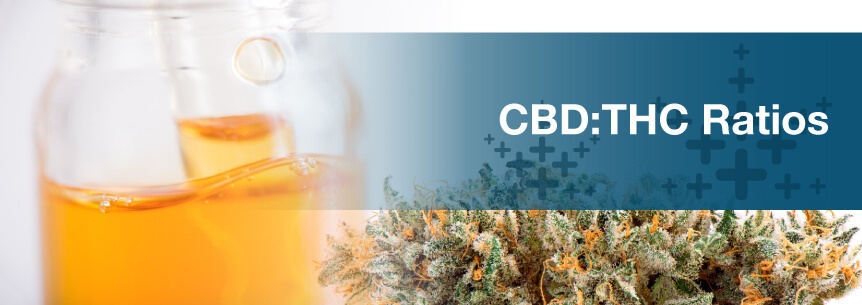
The two main cannabinoids, CBD and THC, contain valuable and distinct medicinal properties and when you take them either together or individually, they have different effects on your body. Since CBD and THC are the cannabis plant’s two most prominent cannabinoids, most of the research as of today focuses on the ratio of each. The understanding of cannabinoid ratios is still in the early stagepire alert. Each cannabinoid’s medical and therapeutic properties are distinct. Tetrahydrocannabinol (THC) and cannabidiol (CBD) differ in the way their molecules act on cannabinoid receptors in the brain. THC binds with the CB1 receptor and CBD binds with the CB2 receptor while also blocking CB1 receptors from binding with THC. This means CBD decreases some of THC’s effects, like anxiety and paranoia, as well as THC’s psychoactive high.
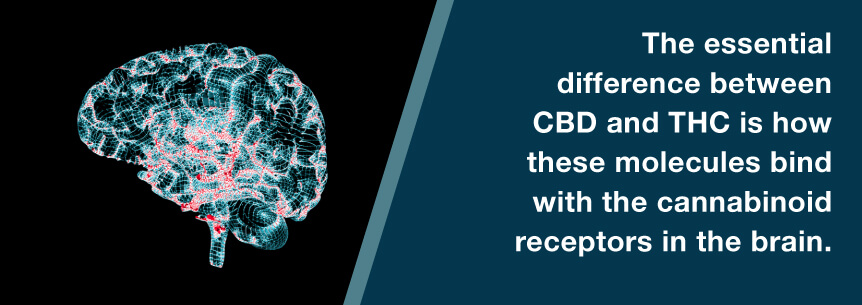
THC acts as an:
It also provides you with a “high” sensation. This means a higher ratio of CBD-to-THC means less of a “high” and, of course, vice versa.
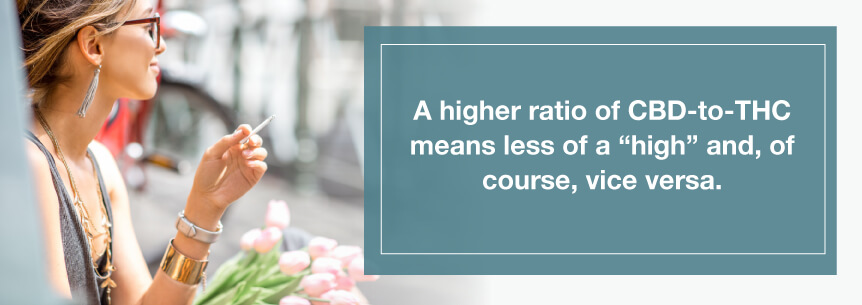
CBD also shares the above THC traits. However, at the same time, it acts as an:
However, CBD doesn’t produce a “high” sensation like THC can. For this reason, many people prefer marijuana having a higher ratio of CBD relative to THC, since consuming a low THC product doesn’t lead to much of a high.
Both cannabinoids have cancer-fighting properties. While CBD can balance THC’s psychoactive effects, it also can provide painkilling and anti-cancer properties. CBD can also reduce a rapid heartbeat and anxiety, which too much THC can bring on. In this way, CBD and THC can work in tandem producing the desired effect.
By blocking CB1 receptors, CBD decreases certain THC effects such as:
The essential difference between CBD and THC is how these molecules bind with the cannabinoid receptors in the brain. THC binds with the CB1 receptor and CBD binds with the CB2 receptor. Different ratios of CBD to THC will, therefore, have different effects.
Varying CBD:THC ratios can affect the way cannabis interacts with your body. Research is still ongoing, but here is an overview of main CBD:THC ratios.
When you consume THC-only products and strains in high doses, you’ll likely experience its psychoactive effects. You may even enjoy this. However, some don’t and prefer medical marijuana’s medicinal properties only. Many people may find the high THC, low CBD strain too overwhelming.
High-THC strains are known to be:
They may also produce dizziness and laughter.
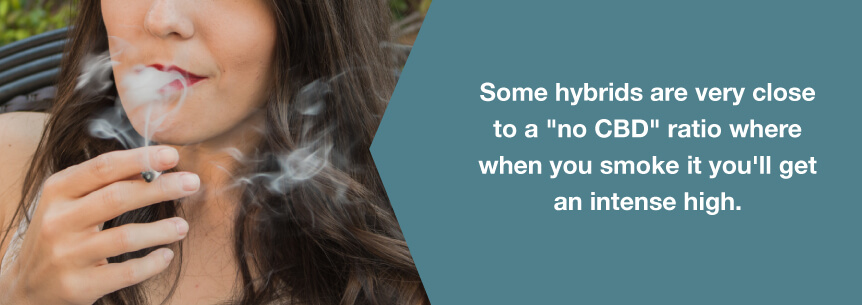
Some hybrids are very close to a “no CBD” ratio where when you smoke it you’ll get an intense high. Girl Scout Cookies is a low-CBD strain and consists of 22 percent THC content. Some hybrid strains are pushing the THC limits, like Gorilla Glue and Critical Kush, which both have about 25 percent THC.
The 1:0 CBD:THC ratio strain produces no high. However, it still enhances your overall mood. Along with this, it provides a great deal of therapeutic potential for treating epilepsy, mood disorders like psychosis and more without side effects.
With this ratio, you’ll still experience THC’s high, but since there’s CBD present in the strain, you’ll be more likely to feel relaxed instead of anxious and paranoid like high-THC strains can bring on.
Equal CBD:THC ratios typically produce mild psychoactive effects. Patients find a 1:1 CBD:THC ratio offers more medicinal qualities for some conditions like:
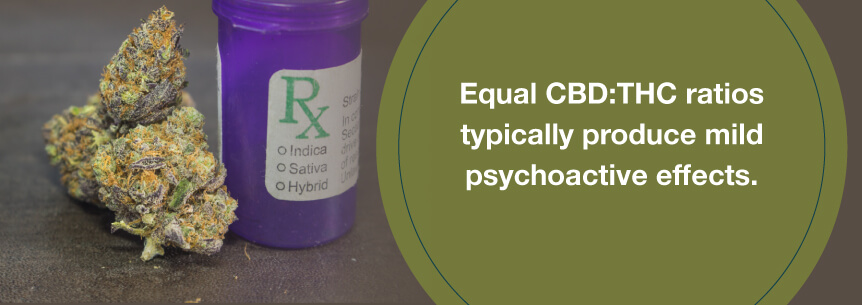
A weed strain with this CBD to THC ratio tends to offer a minimal high while promoting relaxation, calmness, euphoria and tranquility. There are minimal side effects too.
This is a higher CBD ratio strain and tends to eliminate THC’s effects like anxiety, paranoia and euphoria. Higher CBD ratio strains are ideal for sensitive patients or patients who aren’t looking to get high. With higher CBD content strains, THC’s effects are so mild, patients hardly notice them. High CBD, low THC ratios seem to be beneficial for children since they are not psychoactive, yet contain the therapeutic benefits THC offers.
Some patients with depression, anxiety, pediatric seizure disorder and spasms find they do well with a moderate dose of a CBD-dominant ratio, or high CBD strains.
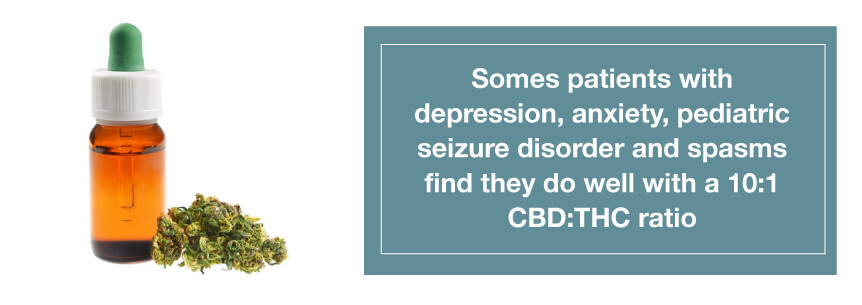
These high THC strains are best suited for recreational use. However, some people can benefit from THC dominant strains for help with migraines, nausea, pain relief, insomnia, glaucoma symptoms and stress management.
CBD to THC ratios are mostly determined by strain genetics. The genetic code of the plant determines how it produces these two compounds. Marijuana plants, as with most plants, have two copies of each gene. The enzymes E1 and E2 convert CBGA into THCA or CBDA are encoded by a couple of distinct forms of the same gene.
Since all plants have two copies of the gene, it presents only a few possibilities:
This means there are three general THC:CBD ratio strain categories that don’t account for any other compounds are:
Amnesia Haze is a potent sativa-dominant with high amounts of CBD, but also with strong THC content. It’s a commonly-used medical strain.
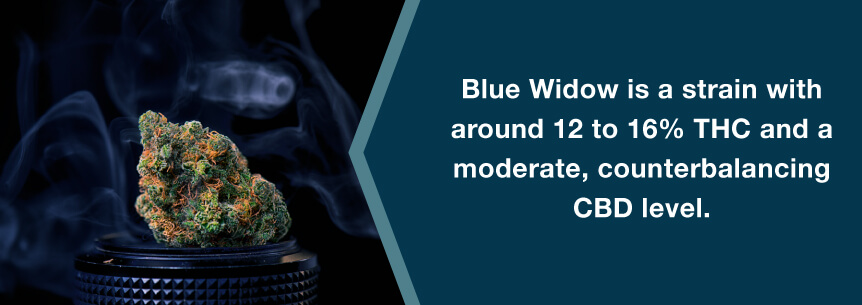
Blue Widow is a strain with around 12 to 16 percent THC and a moderate, counterbalancing CBD level. It’s a crossing between Blueberry and White Widow. OG Kush can often reach more than 20 percent THC content and target various conditions like:
Strains like Harlequin and Blue Dream produce different effects largely in part because of their different THC:CBD ratios.
Research on THC and CBD being used simultaneously is in its infancy stages. But, individuals report less anxiety and better effects with hybrids containing a proportionate balance of both THC and CBD than they do when they use high THC strains alone. Both THC and CBD stimulate neurogenesis — the development of new nervous system cells.
You’ve likely witnessed different CBD:THC ratios when searching for certain strains and edibles, but do you know what they mean?
Each CBD:THC ratio has a significant role in how marijuana acts in your body. Instead of thinking of a marijuana dose in the form of percentage or milligrams, ratios are now starting to become more important information as more individuals use the herb for its healing powers. Each ratio can assist with medical conditions effectively, but there still needs to be more research.
There’s no “perfect ratio” with CBD:THC ratios when it comes to how it will work for you specifically. Each is unique in how they’ll react to certain ratios and certain times of the day. One individual may prefer a 2:1 THC:CBD ratio, while another individual prefers a 0:5 ratio. Also, certain conditions might require different terpenoid and cannabinoid profiles along with managing medical pot around other drugs to avoid cross-reactions. For a lot of individuals, however, a THC-CBD 1:1 ratio is ideal.
Botanists have been wise to the three general categories above for a while now. As mentioned earlier, many commercial strains consist of low CBD levels and high THC levels. Hemp strains, for instance, produce little THC but more CBD. Balanced strains, as the name suggests, produce both THC and CBD. THC-dominant seem to dominate the flower products on the shelves of dispensaries. However, more and more these days, CBD products are gaining popularity.
When it comes to THC content, the low end of the THC-dominant strains is eight to 10 percent dry weight marks. There could be lower levels than this. The stronger strains can be slightly over 30 percent and even higher, although rare.
You’ll also find an upper biological limit on the production of THC — roughly a limit of 35 percent total by dry weight. High THC strains, on average, contain around 18 to 20 percent total THC. If you see anything claiming to be over 35 percent, you may want to question it.
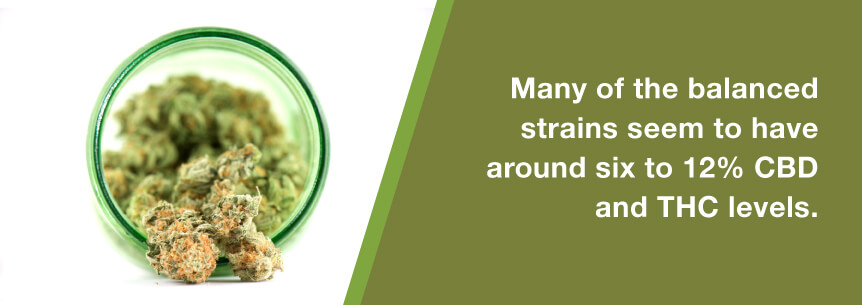
Many of the balanced strains seem to have around six to 12 percent CBD and THC levels. The biology of CBD and THC production prevents you from seeing a strain with 10% CBD and 30% THC or a strain with 30 percent both.
Although ratios of cannabinoids in most weed might be around the same, it’s the terpene content creating the distinct qualities for the most part that’s defined as the distinction between sativas and indicas. Its probable terpenes could alter cannabinoid properties too. Standardized testing is important to advance researchers understanding of this problem.
If you’re not using marijuana medicinally, profiling is important since it lets you know how a certain strain will taste and how much of a high you’ll get. Medical marijuana is a medicine you personalize. With medical weed, there’s no one particular ratio, concentrate or strain that’s perfect for everyone. Each individual’s sensitivity to THC will be the deciding factor in determining the right dosage and ratio for effective usage.
The adequate strength and dose needed will depend on you and the condition you’re treating. Some individuals don’t like THC’s intoxicating effects; others crave it and find it works well to alleviate their symptoms. CBD lessens the potentially unpleasant and intoxicating effects of THC.
A popular therapeutic method appears to be administering constant and measurable CBD doses along with as much THC as an individual can handle comfortably. Some ailments tend to respond well to smaller CBD doses with little THC. Others seem to do better with a 1:1 balanced ratio. You may also use different CBD:THC ratios at various times of the day.
Studies on using CBD and THC simultaneously are less robust and you can trace its history back to the mid-1970s in Brazil. During a study, doctors gave patients around 15 to 60 mg of CBD together with 30mg of THC and measured the effects. Patients reported less anxiety and more pleasurable effects when the two were combined than how they felt using THC by itself.
Also, other scientists examined the effects of giving patients six times the dose of CBD than THC and found 73 percent of the patients said they experienced a reduced “high” feeling than what they experienced with THC by itself.
Other studies showed combining the two cannabinoids decreased the patients’ experiences such as:
The results here are supporting the theory CBD acts by minimizing some of THC’s negative side effects.
Current research into CBD:THC ratios is through the industry of pharmaceuticals, particularly around Sativex — the GW Pharmaceuticals drug which has a THC:CBD ratio of 1:1. In drug development clinical trials, researchers investigated the effects of CBD, THC and combination extracts on pain control, sleep and muscle spasms. Results showed a THC:CBD 1:1 extract offered the most beneficial relief.
CBD and THC together show therapeutic promise for diseases that haven’t had many treatment breakthroughs to date.
Everyone’s endocannabinoid system (ECS) is unique, and its likely different individuals will require unique ratios to obtain the effect they’re looking for. Although the THC:CBD ratio of 1:1 is popular and common, it’s by no means the one true cannabis medicine dose. It may, however, be a great ratio for beginners to start with.
Your first step into finding your appropriate cannabis therapy is finding your perfect ratio. Depending on the state you live in, cannabis dosed medication is presently available in the form of:
Oil extracts have various CBD and THC ratios measured to meet each particular patient’s sensitivities and needs.
THC at high doses, although not lethal, can amplify mood and anxiety disorders. There are no negative side effects associated with CBD at any dose. However, there can be problematic drug interactions to watch out for. A large amount of CBD can be therapeutically less effective than a moderate dose. So, when it comes to cannabis therapy — less can be more.
Many patients report starting slowly with a small dose of a CBD-rich product is the way to go for treating:
CBD can target autoimmune diseases like:
CBC-dominant strains can help with different types of inflammation and chronic pain, and could be helpful in the treatment of cardiovascular diseases, cancer and antibiotic-resistant infections.
For cancer, autism, neurological disease, and many other ailments, patients may benefit from a balanced ratio of CBD and THC.
In Amyotrophic Lateral Sclerosis (ALS), the cannabinoid THC seems to increase long-term survival and delay motor deterioration. Current work that’s building upon this research shows mixing CBD with THC results in a 14 percent rise in increased survival rate and motor performance than THC by itself.
Medical cannabis is already well-known for helping cancer patients relieve their chemotherapy-related nausea. Also, CBD and THC both possess antiangiogenic and cytotoxic qualities, which means they help develop new blood vessels and destroy cancer cells. They both are important to preventing cancer from spreading throughout the body which makes whole-plant marijuana extracts a potential medical choice.
Determine the amount of cannabis you need to help with your health condition. Here’s what you need to do:
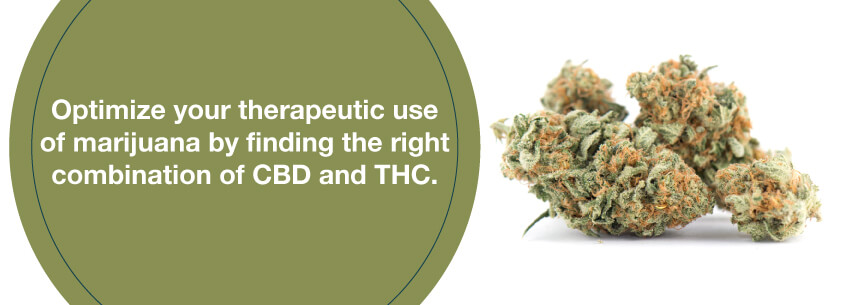
Dispensaries typically have the best CBD:THC ratio products to help you choose which products will benefit you the most. You should get up-to-date on CBD now that it’s sharing the spotlight with its partner cannabinoid, THC. Learn how it will interact with your specific medical condition and your body.
While cannabinoid ratios, particularly CBD:THC ratios are still in their early stages, you still should maintain a “whole plant medicine” mindset. Even though CBD is beginning to grow in popularity, you can’t think of any one cannabinoid as being far better than the others.
For more information on CBD to THC ratios, you may want to sit down and consult with a qualified cannabis doctor. They’ll point you in the right direction of how to get started with your medical cannabis treatment so you too can start to benefit from medical marijuana. You’ll also want to speak with an experienced budtender at a dispensary who is knowledgeable about CBD:THC ratios. Many cannabis products have the CBD:THC ratios available.
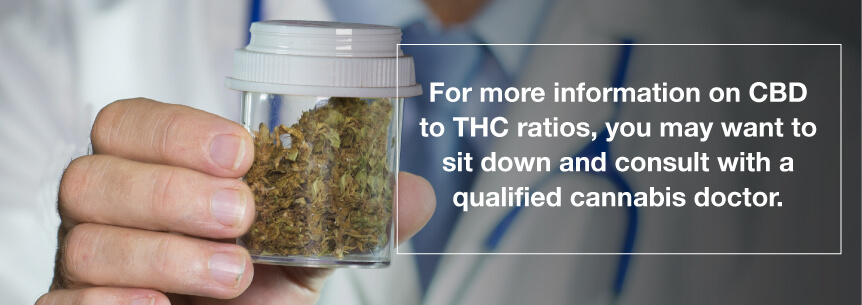
You can search for a medical marijuana doctor and locate a cannabis dispensary, all right here at MarijuanaDoctors.com. As we aim to be your go-to resource for education and information on medical marijuana, take advantage of our many helpful resources to learn more about choosing the right CBH to THC ratio or strain to meet your therapeutic needs. We encourage you to sign up for our newsletter as well.